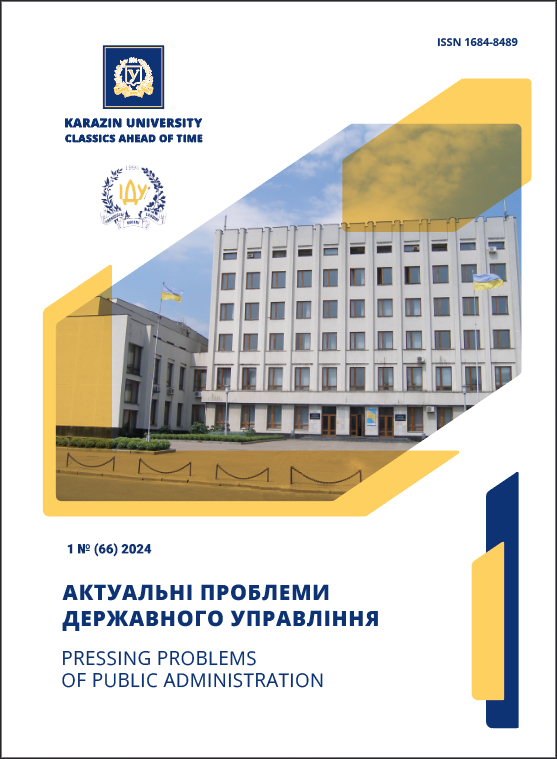Convergence of blockchain technologies and public administration: a tokenization model for post-war ecosystem restoration
Abstract
This article examines a critical issue for Ukraine: the restoration of damaged bioresource potential resulting from military actions through the implementation of innovative tokenization mechanisms. In conditions of limited budgetary resources, where traditional models of state funding prove incapable of innovative breakthroughs, alternative approaches to attracting private capital gain particular significance. The methodological foundation of the research is an interdisciplinary approach that integrates theoretical concepts of decentralized information platforms, platform economics, and noninstitutional theory. Based on an analysis of global experience, six primary models of bioresource tokenization have been identified, and their key components determined: technological verification infrastructure, legal framework, community participation mechanisms, integration with public administration, and a hybrid approach to monetization. A conceptual model of interaction between public administration bodies at various levels and private investors has been developed, based on the principle of a “regulatory perimeter,” where public administration functions as a regulatory facilitator rather than a direct operator of tokenization processes. The research substantiates that cultivating paulownia, a fast-growing species with high carbon sequestration capacity, in affected territories using tokenization technologies can provide a projected profitability of 80-120% over a six-year cycle with investment fractionalization and democratization of access. Four groups of potential risks (regulatory-legal, technological-infrastructural, ecological-economic, and social-institutional) have been structured, and a comprehensive approach to their mitigation has been developed. The study demonstrates that the proposed model allows transforming the role of public administration from direct management to creating a favorable environment for synergy between state and private efforts, ensuring balance between economic growth, environmental sustainability, and social justice. The research results can be used in developing state strategies for restoring affected territories, forming the institutional and legal framework for natural resource tokenization, and implementing pilot public-private partnership projects in bioresource potential restoration.
Downloads
References
Kud, A. A. (2022). Metodolohichnyi pidkhid do formuvannia mekhanizmu modernizatsii systemy publichnoho upravlinnia na osnovi detsentralizovanykh informatsiinykh platform [Methodological approach to the formation of a mechanism for modernizing the public administration system based on decentralized information platforms]. Visnyk pisliadyplomnoi osvity. Seriia «Sotsialni ta povedinkovi nauky», 21(50), 160–220. https://doi.org/10.32405/2522-9931-2022-21(50)-160-220
Kud, A. A. (2024). Mekhanizm tokenizatsii valiutnykh tsinnostei dlia modernizatsii natsionalnoi infrastruktury finansovykh rozrakhunkiv [Mechanism of tokenization of currency values for modernization of the national infrastructure of financial settlements]. Aktualni problemy derzhavnoho upravlinnia, 1(64), 56–81. https://doi.org/10.26565/1684-8489-2024-1-04
Lisovyi kodeks Ukrainy vid 21.01.1994 № 3852-XII (z podalshymy zminamy) [Forest Code of Ukraine dated January 21, 1994 No. 3852-XII (with subsequent amendments)]. (1994). https://zakon.rada.gov.ua/laws/show/3852-12
Pro virtualni aktyvy: Zakon Ukrainy vid 17.02.2022 № 2074-IX [On Virtual Assets: Law of Ukraine dated February 17, 2022 No. 2074-IX]. (2022). Verkhovna Rada Ukrainy. https://zakon.rada.gov.ua/laws/show/2074-20
Agreena & HeavyFinance. (2023). Ofitsiini zaiavy kompanii ta interv'iu z kerivnytstvom [Official company statements and interviews with management]. https://www.agreena.com/ & https://www.heavyfinance.eu/
Bate, G. W. (2025). Blockchain and the Future of Tokenization. Research-Technology Management, 68(3), 59–62. https://doi.org/10.1080/08956308.2025.2476933
Bateman, I., Mace, G., Fezzi, C., Atkinson, G., & Turner, R. (2011). Economic analysis for ecosystem service assessments. Environmental & Resource Economics, 48, 177-218.
Best RWA projects with 50x potential. Dedicated review. Top 5 Altcoins for your crypto portfolio in 2024. (2024). https://surl.li/sdgqqu
Candi, M., & Kahn, K. B. (2025). Comparing Outside-In, Inside-Out, and Coupled Open Innovation Knowledge Flows. Research-Technology Management, 68(3), 11–24. https://doi.org/10.1080/08956308.2025.2468129
CoinDesk. (2025). Tokenized Funds' Rapid Growth Comes With Red Flags: Moody's. https://www.coindesk.com/markets/2025/04/09/tokenized-funds-rapid-growth-comes-with-red-flags-moody-s
European Parliament. (2023). Markets in Crypto-Assets Regulation (MiCA) - Regulation (EU) 2023/1114. Official Journal of the European Union. https://eur-lex.europa.eu/legal-content/EN/TXT/?uri=CELEX:32023R1114
Harish, A., Wu, W., Li, M., & Huang, G. (2023). Blockchain-enabled digital asset tokenization for crowdsensing in environmental, social, and governance disclosure. Computers & Industrial Engineering, Article 109664. https://doi.org/10.1016/j.cie.2023.109664
He, Z., & Turner, P. (2022). Blockchain applications in forestry: A systematic literature review. Applied Sciences, 12(8), 3723. https://doi.org/10.3390/app12083723
Howson, P., Oakes, S., Baynham-Herd, Z., & Swords, J. (2019). Cryptocarbon: The promises and pitfalls of forest protection on a blockchain. Geoforum, 100, 1-9. https://doi.org/10.1016/j.geoforum.2019.02.011
Jacob, A. (2023). Bridging Nature and Blockchain: Filipp Bolotov on Web3eco's Vision. https://techbullion.com/bridging-nature-and-blockchain-filipp-bolotov-on-web3ecos-vision/
Liu, B., Li, J., Wang, D., & Liu, H. (2022). Public–private partnerships: a collaborative framework for ensuring project sustainable operations. Engineering, Construction and Architectural Management, 31. https://doi.org/10.1108/ECAM-12-2021-1124
Multilateral Investment Guarantee Agency. (2022). Political Risk Insurance for Fragile and Conflict-Affected Situations. World Bank Group. https://www.miga.org/political-risk-insurance-fragile-and-conflict-affected-situations
Open Forest Protocol. (2023). Ofitsiini pres-relizy ta dokumentatsiia partnerstva z CIFOR-ICRAF [Official press releases and partnership documentation with CIFOR-ICRAF]. https://www.openforestprotocol.org/
ProClima. (2023). Colombian Platform for Climate Projects. https://proclima.net.co/en/
Shalma. (2025). A Deep Dive into the Legal Framework of Real World Asset Tokenization. https://shamlatech.com/a-deep-dive-into-the-legal-framework-of-real-world-asset-tokenization/
Single.Earth. (2022). White Paper: Tokenizing nature for its ecological value. https://www.single.earth/white-paper
Solana. (2023). Case Study: GainForest brings transparency to climate preservation efforts using blockchain technology. https://solana.com/news/case-study-gainforest
Swiss Financial Market Supervisory Authority FINMA. (2018). Guidelines for enquiries regarding the regulatory framework for initial coin offerings (ICOs). https://www.finma.ch/en/news/2018/02/20180216-mm-ico-wegleitung/
Tech.eu. (2021). Forest tokenisation platform single.earth raises $7.9 million. https://surl.li/xbwkln
Top RWA Outstanding Projects In 2024. (2024). https://coincu.com/205295-top-rwa-outstanding-projects-in-2024/
United Nations Environment Programme. (2020). Blockchain Technology and Environmental Sustainability - Foresight Brief No. 019. https://wedocs.unep.org/handle/20.500.11822/34226
World Bank. (2022). Scaling Up Ecosystem Restoration Finance: A Stocktake Report. https://surli.cc/xobmbm
World Bank. (2024). Unlocking Nature-Based Solutions to Accelerate Climate Finance in Fragile and Conflict-Affected Settings (Saffe technical note) (S. Freitag, A. K. Perea Blazquez, L. Jones, & D. Akhmetova, Eds.). https://surl.li/mmbxce
World Bank Group. (2023). Infrastructure Tokenization: Does Blockchain Have a Role in the Financing of Infrastructure? https://openknowledge.worldbank.org/handle/10986/39579
Copyright (c) 2025 Pressing Problems of Public Administratio

This work is licensed under a Creative Commons Attribution 4.0 International License.

